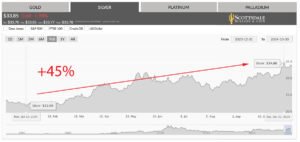Global debt levels recorded a grim record of $312 trillion, according to a report by the Institute of International Finance (IIF). A staggering $2.1 trillion was loaded on top of the already massive debt burden in the first half of 2024, largely due to incessant borrowing from China and the United States — the world’s two largest economies. The financial services group also pointed out the growing contribution from emerging economies, exacerbating the looming debt crisis.
The State of Global Debt
- Global debt hit a record of $312 trillion halfway through 2024.
- Annual global government deficits add up to $92 trillion.
- Experts project worldwide deficits to hit $145 trillion by 2030 and $440 trillion by 2050.
- The US accounts for more than 10% of global debt with a $36 trillion US national debt
What does the report say?
In its Global Debt Monitor report, IIF underscored the alarming rate of debt accumulation on a global scale. Most of the conversation revolves around national debt, but worldwide borrowing has widespread consequences in today’s interconnected economy. The report found that global debt peaked in the middle of 2024 and that, if current trends continue, borrowing levels would quadruple over the next 25 years. The combination of already unsustainable debt levels and exponential borrowing increases poses a serious threat to financial stability across the planet.
No Solutions on the Horizon
The report also bemoaned the lack of concrete measures and general efforts to solve the debt dilemma. “[A] significant concern is the apparent lack of political will to address rising sovereign debt levels in both mature and emerging market economies,” IIF analysts explain.
Emerging Markets Max Out
The report also raises concerns about the growing share of global debt coming from emerging markets. The US and China might be the largest borrowers in total numbers, but rising economies are racking up debt at a faster rate. As more countries reach this phase of rapid economic growth, global borrowing and overall debt are likely to increase even further.
Debt Gets More Expensive
As global debt rises, the ability to pay off that debt is also waning. The US debt-to-GDP ratio — a helpful metric measuring debt as a percentage of gross domestic product — sits near record levels at 120%. Emerging markets saw their collective debt-to-GDP spike by 25% since the pandemic, topping off at 245%. The most worrisome figure is global debt-to-GDP which is around 328%. For context, any number higher than 60% is seen as unsustainable.
👉 Related Read: US Debt Set to Surpass Economic Output Amid Rising Spending
Hidden Hand of Modern Monetary Theory
In the modern economy, most people view debt as a necessary and unavoidable evil. In reality, this is a relatively new concept born out of the Modern Monetary Theory (MMT). This experimental fiscal approach claims that debt cannot ever get too high since the government can simply print or borrow more. No vote ever took place, but this wild theory has been the blueprint for our fiscal leadership for over a decade. Anyone who’s ever balanced a budget understands that astronomical debt would result from endless printing and spending. Unfortunately, our political elites have been kicking this proverbial can down the road for years with no solutions in sight.
Countries Turn Away from Dollar to Gold
As the world reserve currency, the dollar’s health directly affects the world economy. The unchecked spending and printing at home ends up inflating other currencies abroad, leading to more debt accumulation. The debt-laden dollar is losing global confidence vote as countries pursue de-dollarization to protect their economies. In lieu of the dollar, central banks are scooping up physical gold at record rates.
What can investors expect?
Fiscal policy at the federal level can feel out of reach for investors, but the consequences are very real. As entire nations transition to gold, experts are recommending investors do the same. The growing debt crisis will further devalue the dollar and drive central banks and retail investors into gold. This market-wide shift has been the catalyst for the yellow metal’s massive rally. Even with gold at record highs, experts are raising their gold price predictions as the factors driving prices higher are only getting worse.





